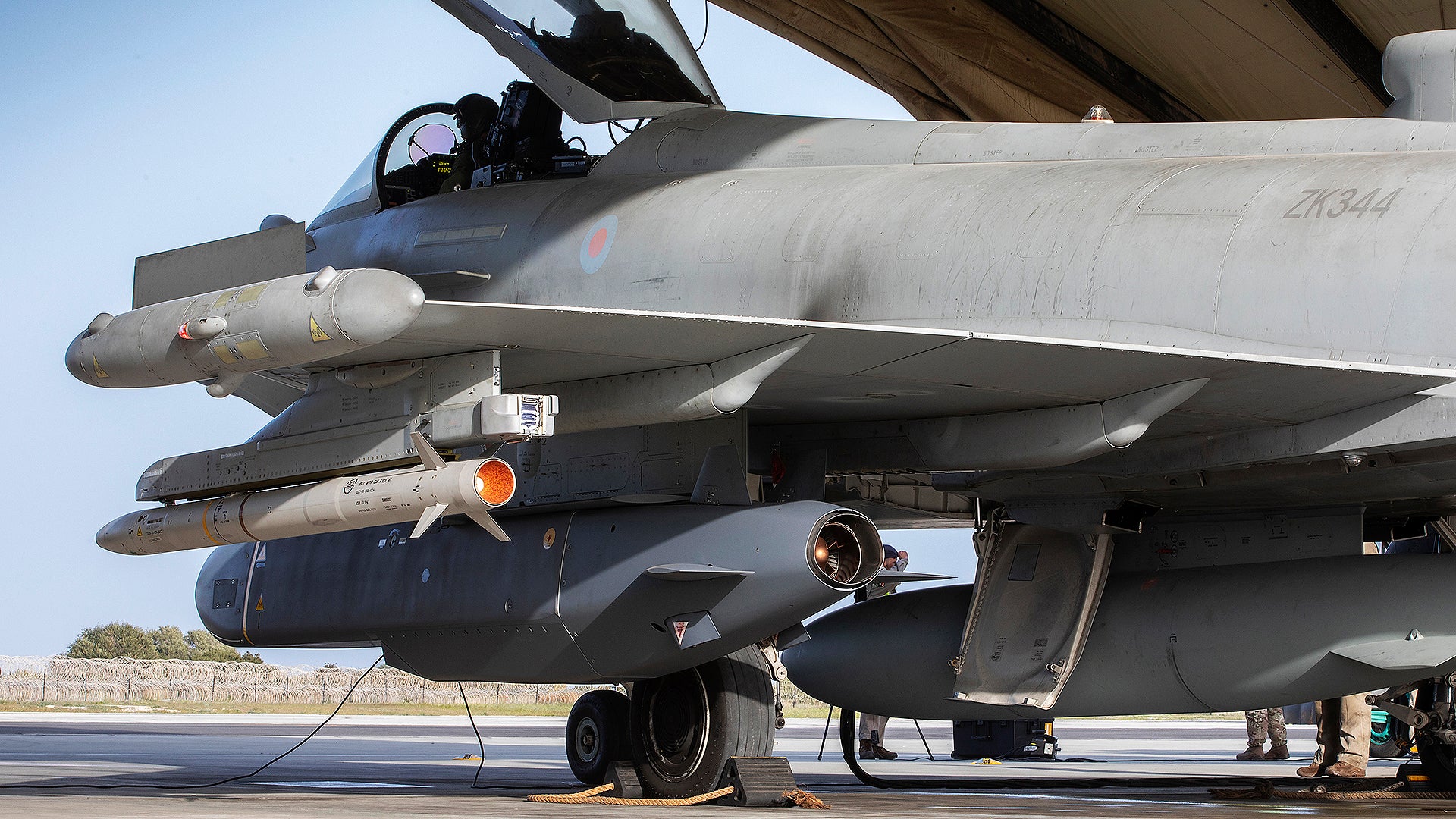UK Royal Air Force Typhoon FGR4 fighter jets have employed the conventionally armed Storm Shadow cruise missile for the first time in combat. The missile was used recently to attack ISIS targets concealed within caves in northern Iraq as part of the UK’s Operation Shader that’s being waged against Daesh in Iraq and Syria.
The UK Ministry of Defense confirmed the Typhoon airstrike against the cave complexes southwest of Erbil. While the weapon was previously used in combat by the Royal Air Force’s (RAF) now-retired Tornado GR4 strike aircraft, this is the first use by the RAF Typhoon.

For the mission in question, which took place on March 11, the Storm Shadow was selected as “the most appropriate weapon for the task,” after Iraqi forces identified “a significant number” of ISIS fighters in the caves. Two Typhoon FGR4s, forward-based at RAF Akrotiri on the island of Cyprus in the eastern Mediterranean, were tasked with the airstrike, which was in support of the Iraqi Counter-Terrorism Service (CTS) ground forces.
The raid was preceded by surveillance of the area by the CTS on March 10, to confirm there were no civilians at risk, and, following the Storm Shadow mission, the “weapons were confirmed to have struck their targets precisely,” according to the defense ministry.
There were also follow-up attacks made on March 11, in the same remote, mountainous area, this time with two RAF Typhoons employing six 500-pound Paveway IV dual-mode precision-guided bombs against ISIS fighters at two other locations.
A different group of caves then came under attack on March 12, with Typhoons employing eight Paveway IVs, and again two days later, using six of the same weapons.
“On each occasion, our aircrew have exercised their utmost care in checking there were no signs of civilians in the area before conducting the strikes and subsequent surveillance to ensure their successful completion,” the defense ministry said.



These latest missions confirm that, although the pace of U.K. offensive air operations in the Middle East has diminished, the RAF is still very much on call and active when required.
It is also telling that, by employing the Storm Shadow, the Typhoon has now well and truly assumed the mantle from the swing-wing Tornado GR4, the retirement of which, back in 2019, you can read about here.
To allow the withdrawal of the Tornado, the U.K. first had to ensure that the Typhoon was able to employ the key air-to-ground weapons that had been used by the Tornado, under a program codenamed Centurion. As well as the Storm Shadow — which was first used by the Tornado during the opening phases of the invasion of Iraq in 2003 and then subsequently during the air campaign over Libya in 2011 — the Typhoon was cleared to use the Brimstone precision anti-armor missile. Paveway IV was already available to the RAF Typhoon.



Centurion modifications actually began to reach the RAF Typhoon front line in early 2018, beginning with the Meteor beyond-visual-range air-to-air missile, then the Storm Shadow, under the Phase 2 Enhancement (or P2E). Brimstone was then added subsequently under P3E and first used in combat by RAF Typhoons in early 2019.

Considering the Storm Shadow has been available to the RAF Typhoon for around three years now, it might seem surprising it’s not previously been used in combat. However, this standoff weapon is, as manufacturer MBDA stresses, “designed to meet the demanding requirements of pre-planned attacks against high-value fixed or stationary targets.”
The missile has a range of over 155 miles and its BROACH warhead is of the tandem type, ensuring penetration of hardened targets, like bunkers or even some cave complexes. The warhead uses a precursor charge to punch through hardened structures followed by the main change that can be fuzed for penetration mode when required, meaning it detonates after breaching the target. The missile guidance system combines an inertial navigation system, GPS, and terrain referencing.



Even before the Storm Shadow was integrated with the Typhoon, the air war in Iraq and Syria didn’t provide many targets of the type for which the missile is optimized. However, it was used by Tornados during the coalition missile strikes against sites connected to the Syrian government’s chemical weapons arsenal, in April 2018, which you read more about here.
Indeed, when it comes to hardened targets or those that are heavily defended, requiring the launch aircraft to remain at standoff range, the Storm Shadow is the weapon of choice for the RAF. For a target like the Erbil caves there are currently no heavier (1,000- or 2,000-pound) Paveway guided bombs available to the Typhoon, and no other bunker-busting alternatives. The Brimstone, for its part, offers a low-collateral, high-precision strike capability.
The Storm Shadow has also been used in combat by Saudi Arabia during its campaign against the Houthi rebels in Yemen, according to the then U.K. Defense Secretary Michael Fallon, speaking in 2016. However, this would have involved Royal Saudi Air Force Tornados and it’s not known if Saudi Typhoons have also used it in anger since then.



It should be noted that France’s version of the Storm Shadow, the SCALP, has also been used in combat, and has been exported to countries including Egypt and India. A naval version of that same weapon has also been developed for launch by surface warships and submarines.
Not in the least thanks to a unit costs of over $1 million, the Storm Shadow is likely to remain a niche weapon for the RAF Typhoon Force in Operation Shader. However, the fact it’s now being used in combat further reinforces the jet’s multirole credentials and its status as the backbone of the UK’s fast jet fleet.
Contact the author: thomas@thedrive.com
